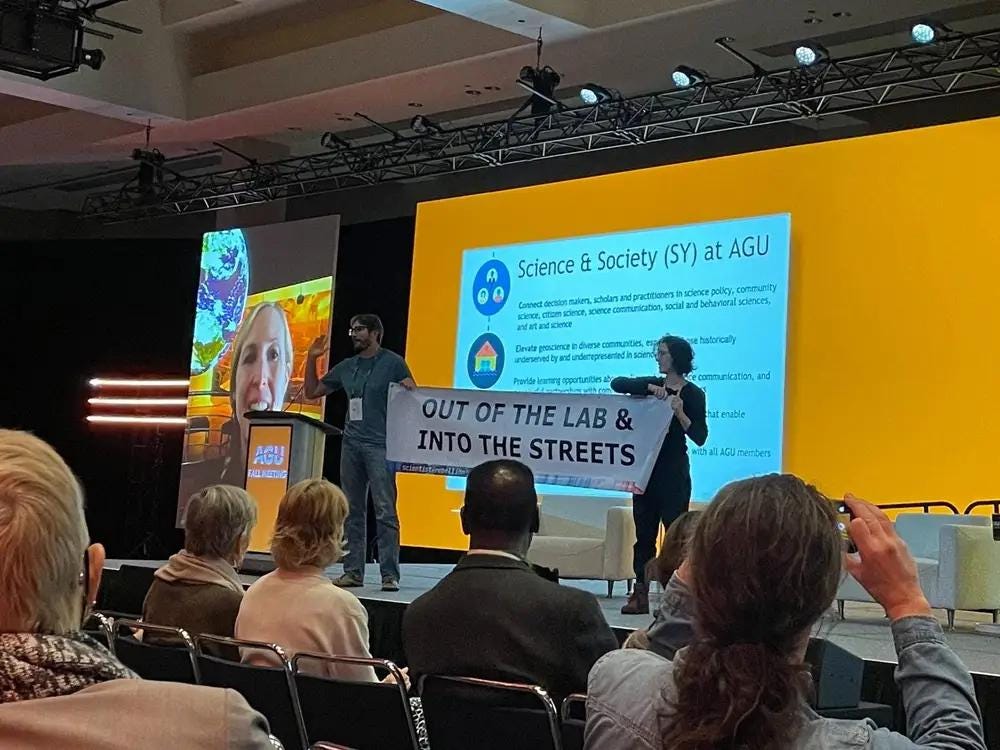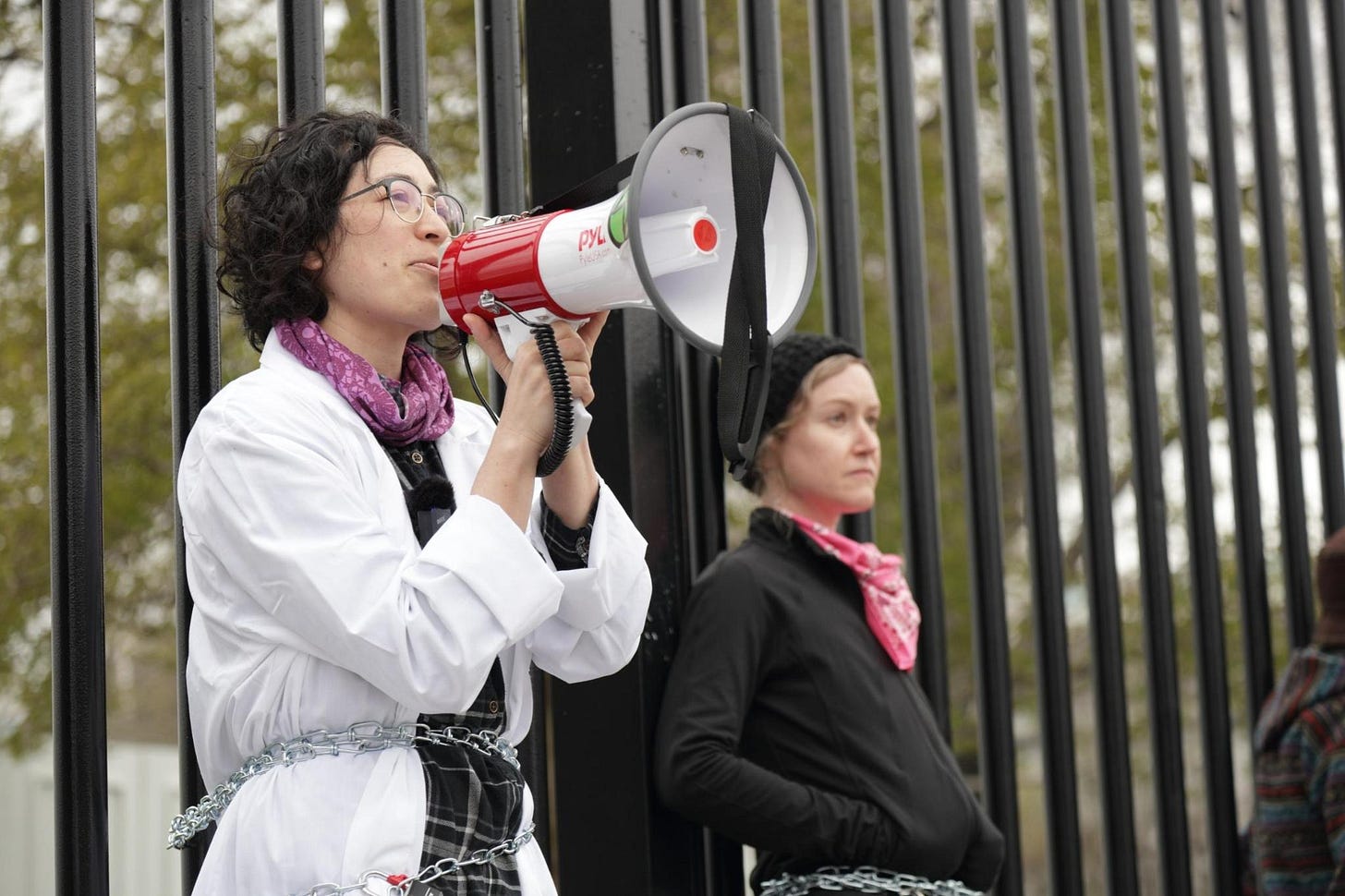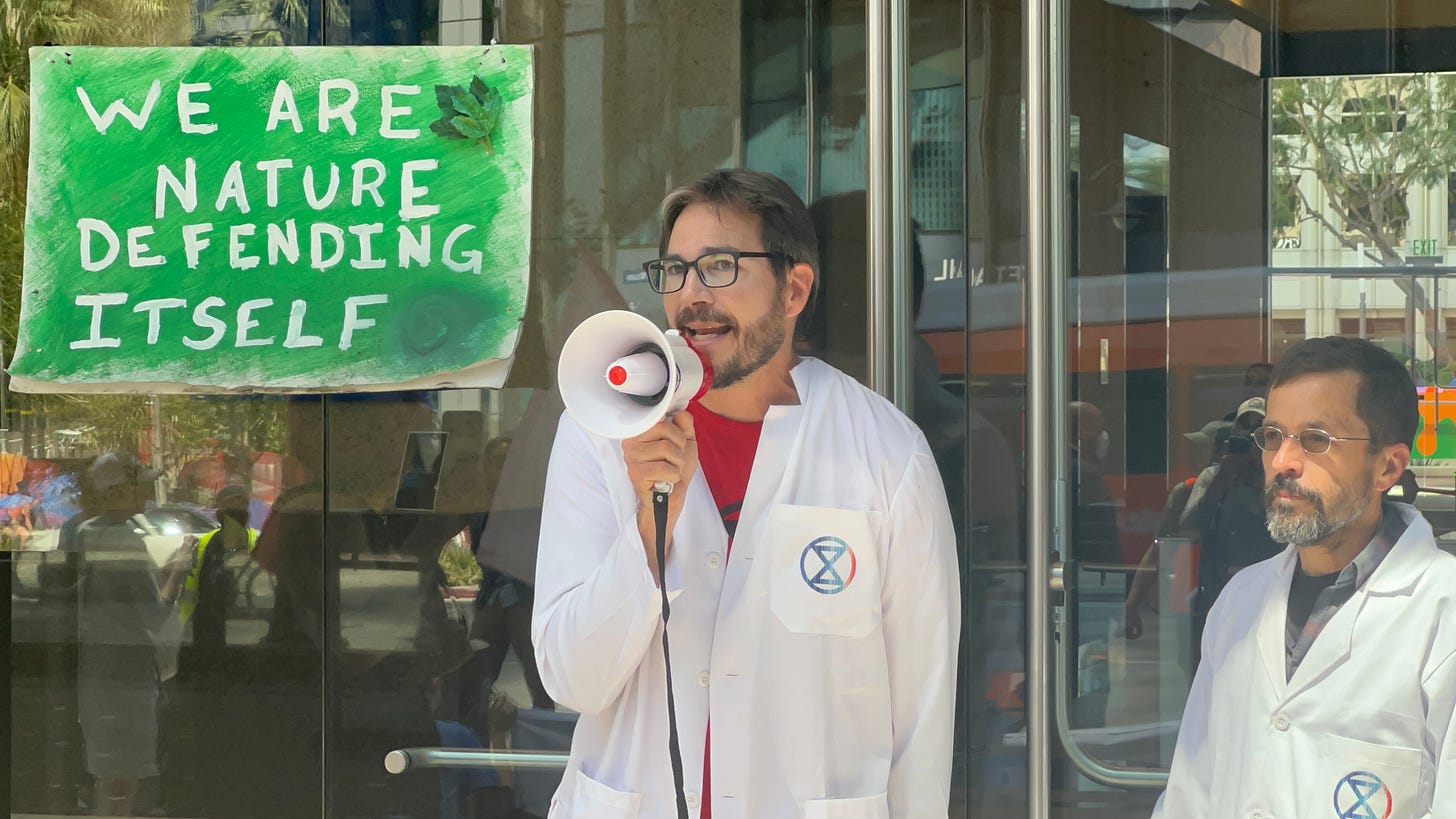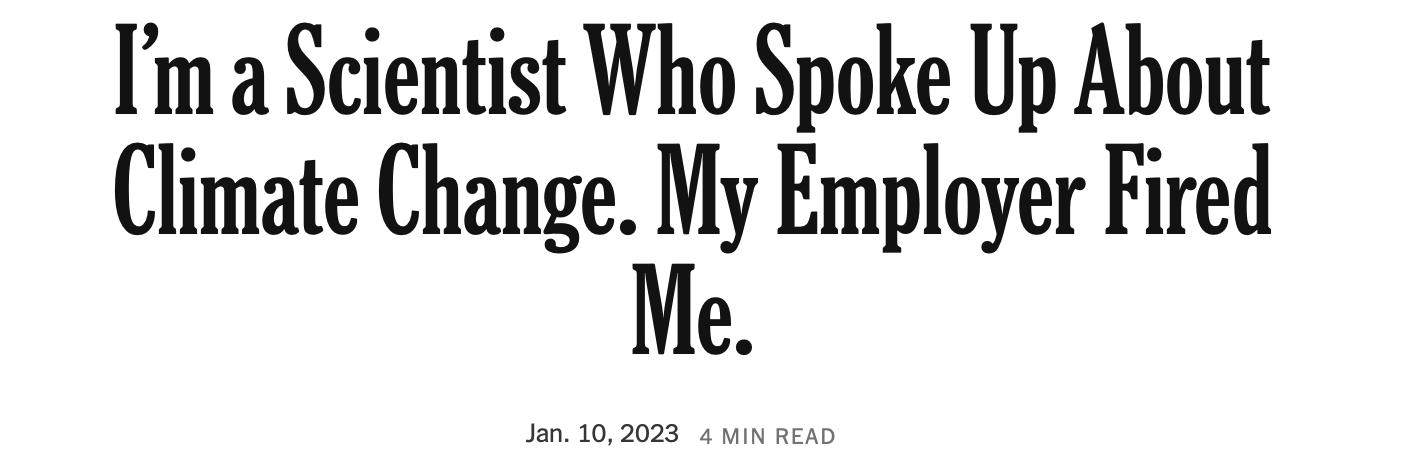What really happened at AGU?
A protest at the world's largest Earth science conference led to a high-profile climate scientist's firing. Was it justified?

On a quiet Thursday afternoon in mid-December, two prestigious climate scientists stepped on stage at the world’s largest Earth science conference, holding a banner that read, “Out of the lab, into the streets.”
A few weeks later, one of them was out of a job.
Rose Abramoff and Peter Kalmus’s protest on an otherwise unremarkable day at the American Geophysical Union (AGU) conference in Chicago has since become the talk of the scientific community. It kicked off an ethics investigation into both scientists; the loss of Abramoff’s job measuring soil carbon emissions at one of the world’s premier research institutions; and a flurry of debate across social media after she wrote about being fired from Oak Ridge National Laboratory for the New York Times.
According to the op-ed and other media reports, Abramoff and Kalmus—who works at NASA’s Jet Propulsion Laboratory—were also banned from the conference, threatened with arrest if they re-entered, and their research was withdrawn from the annual event (a weighty consequence for a publishing scientist). In response, more than 2,000 scientists have signed a letter decrying AGU’s actions.
This wasn’t the first-ever protest at AGU, which has welcomed climate action in the past. But it was the first time a scientist has been fired as a result of participating in a protest at the conference. We decided to dig into this story to assess the appropriateness, and potential ripple effects, of such an unprecedented decision.
What really happened at AGU?
HEATED contacted a dozen scientists, multiple sources at AGU, Oak Ridge, and the Department of Energy (which funds Oak Ridge) to suss out more details of what happened. Many scientists would only speak on the condition of anonymity, citing fears that they might lose their jobs.
Kalmus spoke to HEATED on his own behalf, but still expressed fear that it could affect his employment and ongoing research on how fatal humid heat could impact humanity. The scientists that did feel free to speak to HEATED were ones that felt their institutions supported them fully when they protested.
From the accounts we got, here’s what we learned.
A pre-protest brush with police
Abramoff and Kalmus’s brush with AGU officials didn’t actually start with the protest. It started the day before.
Kalmus was leading a grief circle: a therapy-like exercise in which scientists shared their feelings over climate change and inaction. The participants moved from their registered meeting space to the atrium-like foyer of the conference.
Abramoff and other scientists said AGU officials approached them and asked them to move down the hall, even though there were other circles of people in the foyer. The participants complied, but the officials approached them again, along with at least six security and Chicago police officers.
AGU officials and officers then asked the circle to disperse, saying they needed to clear the hallway for a banquet that was ending nearby. Abramoff and another scientist agreed to leave, but bought time for the others to finish sharing their stories. Abramoff said she gave her phone number to one of the AGU officials. HEATED independently identified this official as the senior vice president of meetings, Lauren Parr.
Asked for comment, an AGU spokesperson said Chicago PD was present because police presence is routine at conferences. They did not have an explanation for why the circle was asked to leave the building. They would not confirm whom Abramoff spoke with.
A monumental session, interrupted
The next day, Kalmus and Abramoff interrupted a panel at the conference, asking scientists to speak up about the need for climate action.
The panel they interrupted was the first-ever AGU plenary session on art and science, moderated by the first-ever trans scientist to lead such a session at AGU, Art Institute of Chicago climate scientist Mika Tosca. More than 1,000 people were in attendance.
Abramoff and Kalmus interrupted the event before the panelists took the stage, but session chair Kate Semmens was about to introduce the panelists over the loudspeaker. As a result, all three spoke at the same time.
“Our science is showing that the planet is dying. It’s terrifying. Everything is at risk,” said Kalmus from the stage, trying to be heard. “As scientists, we have tremendous leverage, but we need to use it. We can wake everybody up.”
“Please, please, please find a way to take action,” said Abramoff, before a woman approached the stage and pulled the banner out of her hands. Abramoff and Kalmus were then escorted from the stage by AGU staff.
Scientists we spoke to said the protest’s timing left them disappointed because it eclipsed the panel's message of hope and its featured artists. “I'm supportive of disruptive activism and I respect Peter and Rose as colleagues,” Tosca said. “[But] we ran this really amazing panel and all the media seems to care about is the protest that was like 15 seconds long before I even went on stage.”
But many also disagreed with what AGU did in response.
AGU’s swift, confusing response
The American Geophysical Union is a powerful organization, with over 60,000 members worldwide and 23 peer-reviewed journals. Whether a scientist is in good standing with the group can significantly affect their ability to publish and disseminate research. It can make or break a scientist’s reputation.
Following their protest, Abramoff and Kalmus’s standing with AGU was on thin ice. After being expelled from the conference, Abramoff said she received a phone call from Parr (Abramoff did not name Parr in the conversation with HEATED), in which Parr threatened arrest if the two returned; said their research would be removed from the conference; and that AGU would contact their work institutions.
An AGU spokesperson would not confirm whether Parr was the one who called, if she threatened arrest, or whether she contacted Abramoff and Kalmus’s employers. A source with knowledge of the AGU ethics process implied she had not contacted them, and that the tip off had come from a colleague at Oak Ridge. But AGU would not confirm that on the record, citing the ongoing investigation.
The AGU spokesperson also attempted to prevent HEATED from naming Parr, claiming she had been receiving significant harassment and death threats. In an e-mail they asserted to be off the record (HEATED had not agreed to an off the record conversation), they said a “middle school-style gossip mill” had “ignited some very dangerous elements online who are not afraid to make direct threats to AGU staff members.“
“I am truly concerned for them and their families' safety,” the spokesperson said. “Many of our staff have had to delete accounts.” HEATED asked for verification of the harassment, but AGU declined to provide any, citing its members’ privacy. Parr declined to comment.
In a letter to its members, the institution stood by its decision to launch an investigation, saying the organization needs “to ensure the safety of all attendees and that our scheduled programming and presenters are free from interference.”
Asked to explain how the protest endangered others, an AGU spokesperson referenced the recent mass shootings in California. “That element of surprise is something that unfortunately these days…we live in a time where we just don't know,” they said.
Asked who made the decision to remove Abramoff and Kalmus’s research, the AGU spokesperson said they believed the action was automatic following a scientist’s removal from the conference.
However, AGU’s own ethics policy says withdrawing a scientists’ research is a sanction that happens following an investigation—and the investigation is still underway. When asked about that policy, the spokesperson's answer changed.
“The decision to pull research papers is on a case-by-case basis,” they said, and added that because the ethics committee is still investigating, “There is nothing more we can comment on until their work has been concluded.”
A scientist gets fired
The AGU investigation may still be underway, but Oak Ridge had all the information it needed to fire Abramoff. The lab’s guidelines state that federally-funded scientists must clearly separate their activities as a private citizen from their activities as an official with their organization.
Abramoff had already received a warning to that effect. In April 2022, after she chained herself to the White House fence to get President Biden to declare a climate emergency, the lab told her to make it clearer she was acting on her own behalf.

Abramoff had hoped to stay on the right side of that line by protesting at a lunchtime session—that is, her personal time. But ultimately, Abramoff said Oak Ridge told her she had misused government resources and failed to adhere to the code of business ethics and conduct.
“We respect the right of all employees to pursue their personal interests outside of work,” Oak Ridge said in a statement. “Those actions, however, must be consistent with company policies, maintain public confidence in our science as an organization, and avoid improper use of taxpayer resources.”
Oak Ridge declined to comment further. But if they had agreed to talk, we would have asked: How did Abramoff misuse government resources? What specific policies did she violate? And how does asking scientists to speak up about the need for climate action diminish trust in climate science?
We’re not the only ones asking these questions.
The chill of self-censorship
When Oak Ridge fired Abramoff, it hit right in the middle of a long-running debate in the scientific community. Some scientists believe that separating their personal opinion from their institutions is good practice to shield research from accusations of bias. Others think it’s dangerous to allow institutions to silence their scientists—and that being honest about their perspective makes them more trustworthy, not less.
But the effect of Oak Ridge and AGU’s actions may go beyond stirring up an old debate. In a blog post last week, the Union of Concerned Scientists wrote that this “may be seen by the scientific community as a strong, disapproving, and chilling signal to scientists to step back from climate activism—just when the world needs them to show up in new, courageous ways.”
The post raises important questions. How do we measure the value of a scientist and her research? Is the loss of a scientist’s job worse than the interruption of a panel, or the loss of objectivity on taxpayer time? When the planet is at risk of becoming uninhabitable, is it time to reevaluate our norms?

AGU wanted Abramoff and Kalmus to play by the rules. The organization said it would have welcomed a panel, or a protest with permission. But the whole point of a disruptive protest is to break the status quo, because the status quo is not responding fast enough to meet the climate emergency.
“I'm really concerned about what's happening on the planet as described by all the science of the AGU, and the weird, surreal sense that everyone just acts like it's normal,” said Kalmus.
“I think the research that I'm doing is really important and helpful. But it's not enough and it's not fast enough,” said Abramoff. “That's what pushed me to much riskier activism than I had been participating in before.”
Because of that risky activism, Oak Ridge has lost an Earth scientist whose research helped other scientists model how the decomposition of carbon stored in soil affects climate change. If no other institution hires Abramoff, the world has lost her future research.
AGU is still reaching a verdict about Abramoff and Kalmus. But in the meantime, the actions of their own officials have sent a clear message that even during a climate emergency, there is still a right time and place to speak.
Editor's note: This story has been updated to clarify HEATED’s independent identification of Parr.
The reporting you just consumed is funded 100 percent by its readers — and we could really use your help keeping it going.
In the last few months, HEATED’s main source of subscribers — Twitter — has become much less effective. As Truthout reported this week, the algorithm since Elon Musk’s takeover has shifted to “lean most heavily toward the successful distribution of myths and disinformation rather than the ability to share grassroots-level resources or reporting that many appreciated in the past.”
This, in addition to looming recession fears, is putting a strain on HEATED’s resources. So if you enjoyed today’s original reporting and you want to see more like it, please consider becoming an annual paid subscriber today. Your support will help innoculate us from the whims of right-wing billionaires like Musk and ensure that HEATED thrives for years to come.
No Catch of the Day today; e-mail length limit won’t allow it. Fish’s friends will be back in your inbox next week.










*sarcasm on*
Official Guidance:
Scientists must at all times remain dispassionate and objective. All data, research, and conclusions will remain in the pages of our 23 peer-reviewed journals that almost nobody reads or cares about.
Scientists may do whatever they please in their free time as long as it is confined to their own home and preferably in a dark closet with their cell phone turned off.
It must be ensured, at all costs, that the public does not have any kind of emotional response to our findings that could affect a chain reaction resulting in public policy.
Going forward we would appreciate that everyone keep their head down and buried in the data.
*sarcasm off*
I hope that Ms. Abramoff lands on her feet, and soon. We ignore her warnings at our own peril.